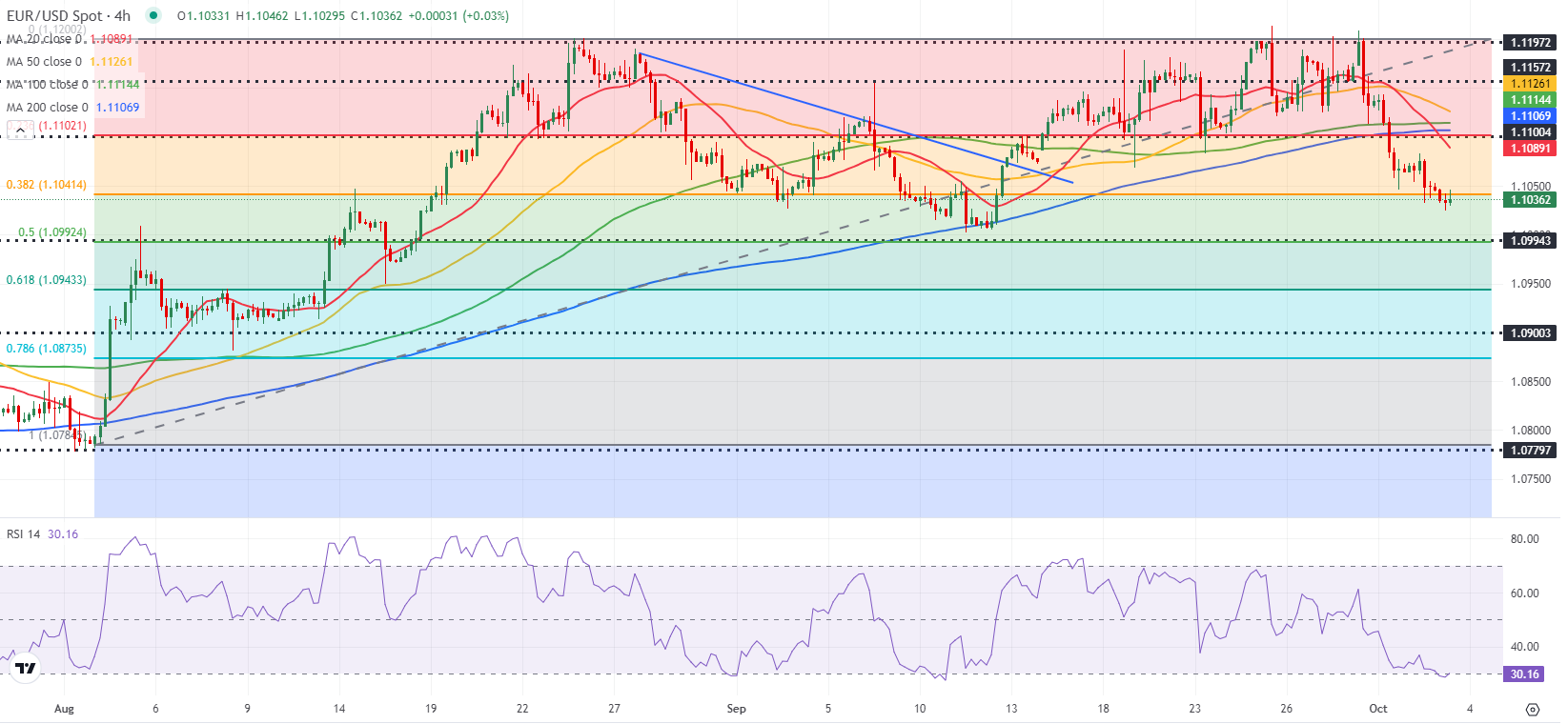- EUR/USD struggles to gain traction after closing in the red on Wednesday.
- The near-term technical outlook points to a lack of buyer interest.
- The weekly Initial Jobless Claims and September ISM Services PMI data could drive the pair's action.
Following Tuesday's sharp decline, EUR/USD continued to stretch lower and closed in negative territory on Wednesday. The pair extended its slide in the Asian session on Thursday and touched its lowest level in three weeks below 1.1030 before staging a modest rebound toward 1.1050 in the European morning.
Euro PRICE This week
The table below shows the percentage change of Euro (EUR) against listed major currencies this week. Euro was the weakest against the US Dollar.
| USD | EUR | GBP | JPY | CAD | AUD | NZD | CHF | |
|---|---|---|---|---|---|---|---|---|
| USD | 1.15% | 2.04% | 3.08% | 0.10% | 0.74% | 1.79% | 1.16% | |
| EUR | -1.15% | 0.88% | 1.93% | -1.02% | -0.36% | 0.66% | 0.09% | |
| GBP | -2.04% | -0.88% | 1.15% | -1.88% | -1.22% | -0.22% | -0.78% | |
| JPY | -3.08% | -1.93% | -1.15% | -2.85% | -2.33% | -1.24% | -1.82% | |
| CAD | -0.10% | 1.02% | 1.88% | 2.85% | 0.69% | 1.69% | 1.12% | |
| AUD | -0.74% | 0.36% | 1.22% | 2.33% | -0.69% | 1.01% | 0.43% | |
| NZD | -1.79% | -0.66% | 0.22% | 1.24% | -1.69% | -1.01% | -0.59% | |
| CHF | -1.16% | -0.09% | 0.78% | 1.82% | -1.12% | -0.43% | 0.59% |
The heat map shows percentage changes of major currencies against each other. The base currency is picked from the left column, while the quote currency is picked from the top row. For example, if you pick the Euro from the left column and move along the horizontal line to the US Dollar, the percentage change displayed in the box will represent EUR (base)/USD (quote).
The risk-averse market atmosphere and the upbeat private sector employment data from the US helped the US Dollar (USD) hold its ground midweek and didn't allow EUR/USD to gain traction.
Meanwhile, cautious comments from European Central Bank (ECB) officials put additional weight on the Euro's shoulders. ECB Vice President Luis de Guindos said that risks to Eurozone growth remains tilted to the downside and ECB board member Isabel Schnabel noted that they cannot ignore headwinds to growth, adding that a return to the ECB's 2% inflation target in a timely manner is becoming more likely.
In the early American session, the weekly Initial Jobless data will be featured in the US economic calendar. Markets expect the number of first-time applications for unemployment benefits to come in at 220,000 in the week ending September 28. Ahead of Friday's critical Nonfarm Payrolls data, a reading close to 200,000 in the weekly Initial Jobless Claims could help the USD gather strength with the immediate reaction.
Later in the day, investors will scrutinize the ISM Services PMI data for September. An unexpected drop below 50 could revive concerns over an economic downturn in the US and make it difficult for the USD to outperform its rivals.
Market participants will also keep a close eye on the risk perception. US stock index futures trade in negative territory in the European session. EUR/USD could stay under bearish pressure if risk-off flows dominate the action in the second half of the day.
EUR/USD Technical Analysis
EUR/USD was last seen trading near 1.1040, where the Fibonacci 38.2% retracement of the latest uptrend is located. In case the pair fails to stabilize above this level, technical sellers could remain interested. On the downside, 1.1000 (Fibonacci 50% retracement) could be seen as next support before 1.0940 (Fibonacci 61.8% retracement).
If EUR/USD manages to reclaim 1.1040, next strong resistance could be seen at 1.1100, where the 100-period and the 200-period Simple Moving Averages (SMA) meet the Fibonacci 23.6% retracement, ahead of 1.1150 (static level).
Euro FAQs
The Euro is the currency for the 19 European Union countries that belong to the Eurozone. It is the second most heavily traded currency in the world behind the US Dollar. In 2022, it accounted for 31% of all foreign exchange transactions, with an average daily turnover of over $2.2 trillion a day. EUR/USD is the most heavily traded currency pair in the world, accounting for an estimated 30% off all transactions, followed by EUR/JPY (4%), EUR/GBP (3%) and EUR/AUD (2%).
The European Central Bank (ECB) in Frankfurt, Germany, is the reserve bank for the Eurozone. The ECB sets interest rates and manages monetary policy. The ECB’s primary mandate is to maintain price stability, which means either controlling inflation or stimulating growth. Its primary tool is the raising or lowering of interest rates. Relatively high interest rates – or the expectation of higher rates – will usually benefit the Euro and vice versa. The ECB Governing Council makes monetary policy decisions at meetings held eight times a year. Decisions are made by heads of the Eurozone national banks and six permanent members, including the President of the ECB, Christine Lagarde.
Eurozone inflation data, measured by the Harmonized Index of Consumer Prices (HICP), is an important econometric for the Euro. If inflation rises more than expected, especially if above the ECB’s 2% target, it obliges the ECB to raise interest rates to bring it back under control. Relatively high interest rates compared to its counterparts will usually benefit the Euro, as it makes the region more attractive as a place for global investors to park their money.
Data releases gauge the health of the economy and can impact on the Euro. Indicators such as GDP, Manufacturing and Services PMIs, employment, and consumer sentiment surveys can all influence the direction of the single currency. A strong economy is good for the Euro. Not only does it attract more foreign investment but it may encourage the ECB to put up interest rates, which will directly strengthen the Euro. Otherwise, if economic data is weak, the Euro is likely to fall. Economic data for the four largest economies in the euro area (Germany, France, Italy and Spain) are especially significant, as they account for 75% of the Eurozone’s economy.
Another significant data release for the Euro is the Trade Balance. This indicator measures the difference between what a country earns from its exports and what it spends on imports over a given period. If a country produces highly sought after exports then its currency will gain in value purely from the extra demand created from foreign buyers seeking to purchase these goods. Therefore, a positive net Trade Balance strengthens a currency and vice versa for a negative balance.
Information on these pages contains forward-looking statements that involve risks and uncertainties. Markets and instruments profiled on this page are for informational purposes only and should not in any way come across as a recommendation to buy or sell in these assets. You should do your own thorough research before making any investment decisions. FXStreet does not in any way guarantee that this information is free from mistakes, errors, or material misstatements. It also does not guarantee that this information is of a timely nature. Investing in Open Markets involves a great deal of risk, including the loss of all or a portion of your investment, as well as emotional distress. All risks, losses and costs associated with investing, including total loss of principal, are your responsibility. The views and opinions expressed in this article are those of the authors and do not necessarily reflect the official policy or position of FXStreet nor its advertisers. The author will not be held responsible for information that is found at the end of links posted on this page.
If not otherwise explicitly mentioned in the body of the article, at the time of writing, the author has no position in any stock mentioned in this article and no business relationship with any company mentioned. The author has not received compensation for writing this article, other than from FXStreet.
FXStreet and the author do not provide personalized recommendations. The author makes no representations as to the accuracy, completeness, or suitability of this information. FXStreet and the author will not be liable for any errors, omissions or any losses, injuries or damages arising from this information and its display or use. Errors and omissions excepted.
The author and FXStreet are not registered investment advisors and nothing in this article is intended to be investment advice.
Recommended Content
Editors’ Picks

AUD/USD tumbles to a five-year low below 0.6000 amid US-China tariffs war
The AUD/USD pair tumbles to near 0.5985 for the first time since the COVID-19 pandemic during the early Asian session on Monday. The Australian Dollar weakens as China slapped a 34% tax on all US imports in retaliation for US President Donald Trump’s tariffs, raising fear of a trade war between the United States and China.

USD/JPY hangs near a multi-month low; holds above 145.00 amid mixed cues
USD/JPY kicks off the new week on a weaker note, though it manages to hold above the 145.00 mark. The global carnage, amid the mounting risk of a recession led by Trump's sweeping tariffs, underpins the safe-haven JPY and weighs on the currency pair amid a bearish USD.

Gold correction deepens after new record-high is set on Trump’s tariff announcement
Gold pushed higher with the initial reaction to tariff announcements from the United States on Wednesday and touched a record peak of $3,167 before staging a deep correction heading into the weekend. Investors will stay focused on tariff-related headlines and pay close attention to inflation data from the US.

Week ahead: US CPI and RBNZ decision on tap amidst tariff mayhem
US Dollar traders await US CPI data amid global trade turbulence. RBNZ to cut by 25bps, could maintain dovish stance. China’s CPI and PPI to reveal tariff impact on inflation. Strong UK GDP data could help the pound climb higher.

Strategic implications of “Liberation Day”
Liberation Day in the United States came with extremely protectionist and inward-looking tariff policy aimed at just about all U.S. trading partners. In this report, we outline some of the more strategic implications of Liberation Day and developments we will be paying close attention to going forward.

The Best brokers to trade EUR/USD
SPONSORED Discover the top brokers for trading EUR/USD in 2025. Our list features brokers with competitive spreads, fast execution, and powerful platforms. Whether you're a beginner or an expert, find the right partner to navigate the dynamic Forex market.
